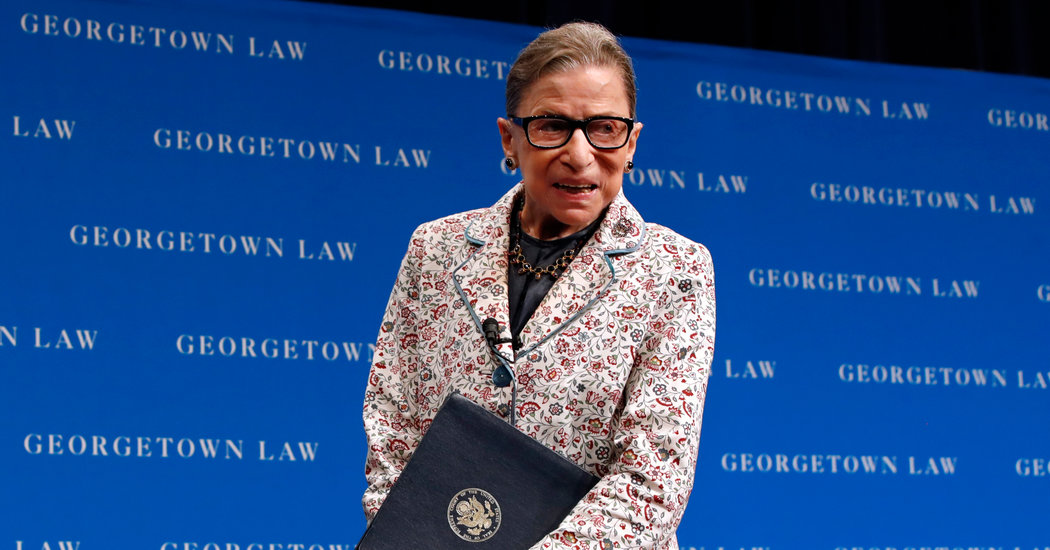
The news about Justice Ruth Bader Ginsburg’s operation for two cancerous lung nodules is encouraging but incomplete.
The lower lobe of her left lung, which contained the two nodules, was removed in surgery on Friday, and scans before the operation showed no signs of cancer anywhere else in her body, according to a statement from the Supreme Court.
“Currently, no further treatment is planned,” the statement said, adding that the justice was expected to stay in the hospital, Memorial Sloan Kettering Cancer Center in New York City, for a few days.
The type of cancer has not been revealed. It may not be known yet if biopsies were not performed before the surgery.
The tumors could be primary lung cancers, meaning they originated in the lung. Or they could be growths that spread to her lung from cancer in another organ. The justice had colon cancer in 1999 and pancreatic cancer in 2009.
“When you have two lesions in the lung, it usually means it came from someplace else,” said Dr. Raja Flores, chairman of thoracic surgery at the Icahn School of Medicine at Mount Sinai in Manhattan. “It’s probably something that spread from the pancreas to the lungs.”
That Justice Ginsberg is alive 10 years after being treated for pancreatic cancer — which is often rapidly fatal — indicates that she probably had a relatively slow-growing form of the disease. Therefore, Dr. Flores said, he expected that the tumors in her lungs would also tend to be slow-growing, what he calls “turtles.”
Testing on the tissue removed during surgery will determine the diagnosis, he said.
“If they see pancreas cells, or colon cells, or just lung cells, that will help dictate further treatment,” Dr. Flores said, but he added that the justice might not need any more treatment.
“The fact that this is out, and there is no evidence of disease anywhere else, makes me think she is not in any danger of checking out anytime soon,” he said. “She should be up walking around tomorrow. As long as she doesn’t get a blood clot or pneumonia, she’s fine. I imagine her back on the bench in six to eight weeks. I would say sooner, but she is 85 years old.”
Dr. Richard S. Lazzaro, chief of thoracic surgery at Lenox Hill Hospital in Manhattan, said that before the biopsies are complete, it would be impossible to tell what type of cancer Justice Ginsburg had in her lung.
The lung nodules were found when Justice Ginsburg was being treated for broken ribs in November. That was a stroke of good fortune, Dr. Lazzaro said, because it meant the tumors were found early, before they had a chance to spread.
“The prospects after you heal are good provided that the tumor is confined to the lung and hasn’t traveled anywhere else,” Dr. Lazzaro said.
If the nodules turn out to be primary lung cancer, they could be two independent tumors, or they could be related, meaning that one had spread to form the other. Two independent tumors would most likely have a better outlook than one that has been spreading, he said.
The statement from the court did not say whether Justice Ginsburg underwent open surgery, which requires a large incision, or a minimally invasive procedure. In the less invasive approach, surgeons work through small slits to remove the diseased lobe, slip it into a bag and then pull it out through one of the slits.
Patients generally have less pain and a quicker recovery with minimally invasive surgery, but it is not always possible.
Dr. Flores said that he had worked for 10 years with Justice Ginsburg’s surgeon, Dr. Valerie W. Rusch, and that she and Justice Ginsburg were a bit alike: small women with big minds who had overcome obstacles in an era that held many women back, rising to the top of their fields.
He said he had seen “RBG,” this year’s documentary about Justice Ginsburg, and was impressed with her exercise regimen.
“She was fantastic,” he said. “I think she’ll do very well.”

